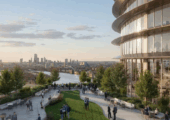 There’s a good reason why we find it hard to establish the causal links between our working lives, office design and our personal happiness. It’s because it’s all very complicated. So complicated in fact that you can sidetrack any discussion on the subject by asking elementary questions such as: ‘what do you mean by happy?’ or ‘should it be the role of work to make us happy?’
There’s a good reason why we find it hard to establish the causal links between our working lives, office design and our personal happiness. It’s because it’s all very complicated. So complicated in fact that you can sidetrack any discussion on the subject by asking elementary questions such as: ‘what do you mean by happy?’ or ‘should it be the role of work to make us happy?’
A lot of commercial interests in the workplace sector would like us to think that there is a correlation between what they do in delivering office design and how happy people are at work, but the research shows that things are never that straightforward.
It all depends not just on a stimulus but how we choose to respond to it. One thing that seems evident is that the design of the workplace would be characterised as a ‘hygiene factor’ according to the work of Frederick Herzberg dating from the 1950s, which explained why the things that motivate us are not the mere opposites of those which make us unhappy.
[perfectpullquote align=”right” bordertop=”false” cite=”” link=”” color=”” class=”” size=””]We must be careful when we attempt to correlate factors in such complex systems[/perfectpullquote]
In practical terms, this means that we are more likely to be happy in a job we love with poor surroundings than a job we hate in the most salubrious of offices. Similarly, if people are stressed because they have an unhappy home life, a different or better office design probably won’t do much to help. That is why we can reject many of the simplistic attempts to equate specific environmental factors with our personal happiness. We must be careful when we attempt to correlate factors in such complex systems.
The source of happiness
A proper understanding of just how complex the relationship between office design, work and happiness is can be gauged by looking at research such as that published in a report by Alex Bryson and George McKerron for the Centre for Economic Performance at the London School of Economics.
The report is based on millions of pieces of data from tens of thousands of people in the UK. The data acquisition method was unique. Respondents were asked to use an app called ‘mappiness’ to record how satisfied, anxious or relaxed they are at a particular moment in response to messages sent to them at random times of the day. Crucially they were also asked what they are (or were) doing at the time the message was sent so that the researchers could relate 40 chosen situations with specific feelings.
Perhaps unsurprisingly people revealed they were most happy when making love or being intimate with loved ones, followed by attending the cinema, concerts or the theatre, then endorphin releasing activities such as sport and exercise.
Work, on the other hand, came second bottom. Only ‘being ill’ made people less satisfied. However, even here a complex picture emerges because the results of the research also showed a clear distinction between the momentary feelings associated with tasks and more general levels of satisfaction related to work. Timing was also important. Those working outside of modern core working times between 6am and 6pm were less happy than those working within them. People working at home were found to be happier than those working in an office.
[perfectpullquote align=”right” bordertop=”false” cite=”” link=”” color=”” class=”” size=””]Happiness while working is a complex issue, dependent on a range of factors[/perfectpullquote]
The report comes to the conclusion that happiness while working is a complex issue, dependent on a range of factors. The authors sum it up as follows: ‘Precisely how unhappy or anxious one is while working depends on the circumstances. Wellbeing at work varies significantly with where you work ; whether you are combining work with other activities; whether you are alone or with others; and the time of day or night you are working.’
This is something that we’ve always known. Happiness at work is something we all strive for, but we must become better at identifying its sources and the things that make us unhappy. This means challenging the core narrative that it is external features of the workplace that are the solution. They only function in this way when they reflect a workplace culture that focuses on happiness and all the other facets of wellbeing.
Mark is the publisher of Workplace Insight, IN magazine, Works magazine and is the European Director of Work&Place journal. He has worked in the office design and management sector for over thirty years as a journalist, marketing professional, editor and consultant.















September 23, 2019
Office design alone cannot motivate us or make us happy at work
by Mark Eltringham • Comment, Knowledge, Workplace, Workplace design
A lot of commercial interests in the workplace sector would like us to think that there is a correlation between what they do in delivering office design and how happy people are at work, but the research shows that things are never that straightforward.
It all depends not just on a stimulus but how we choose to respond to it. One thing that seems evident is that the design of the workplace would be characterised as a ‘hygiene factor’ according to the work of Frederick Herzberg dating from the 1950s, which explained why the things that motivate us are not the mere opposites of those which make us unhappy.
[perfectpullquote align=”right” bordertop=”false” cite=”” link=”” color=”” class=”” size=””]We must be careful when we attempt to correlate factors in such complex systems[/perfectpullquote]
In practical terms, this means that we are more likely to be happy in a job we love with poor surroundings than a job we hate in the most salubrious of offices. Similarly, if people are stressed because they have an unhappy home life, a different or better office design probably won’t do much to help. That is why we can reject many of the simplistic attempts to equate specific environmental factors with our personal happiness. We must be careful when we attempt to correlate factors in such complex systems.
The source of happiness
A proper understanding of just how complex the relationship between office design, work and happiness is can be gauged by looking at research such as that published in a report by Alex Bryson and George McKerron for the Centre for Economic Performance at the London School of Economics.
The report is based on millions of pieces of data from tens of thousands of people in the UK. The data acquisition method was unique. Respondents were asked to use an app called ‘mappiness’ to record how satisfied, anxious or relaxed they are at a particular moment in response to messages sent to them at random times of the day. Crucially they were also asked what they are (or were) doing at the time the message was sent so that the researchers could relate 40 chosen situations with specific feelings.
Perhaps unsurprisingly people revealed they were most happy when making love or being intimate with loved ones, followed by attending the cinema, concerts or the theatre, then endorphin releasing activities such as sport and exercise.
Work, on the other hand, came second bottom. Only ‘being ill’ made people less satisfied. However, even here a complex picture emerges because the results of the research also showed a clear distinction between the momentary feelings associated with tasks and more general levels of satisfaction related to work. Timing was also important. Those working outside of modern core working times between 6am and 6pm were less happy than those working within them. People working at home were found to be happier than those working in an office.
[perfectpullquote align=”right” bordertop=”false” cite=”” link=”” color=”” class=”” size=””]Happiness while working is a complex issue, dependent on a range of factors[/perfectpullquote]
The report comes to the conclusion that happiness while working is a complex issue, dependent on a range of factors. The authors sum it up as follows: ‘Precisely how unhappy or anxious one is while working depends on the circumstances. Wellbeing at work varies significantly with where you work ; whether you are combining work with other activities; whether you are alone or with others; and the time of day or night you are working.’
This is something that we’ve always known. Happiness at work is something we all strive for, but we must become better at identifying its sources and the things that make us unhappy. This means challenging the core narrative that it is external features of the workplace that are the solution. They only function in this way when they reflect a workplace culture that focuses on happiness and all the other facets of wellbeing.
Mark is the publisher of Workplace Insight, IN magazine, Works magazine and is the European Director of Work&Place journal. He has worked in the office design and management sector for over thirty years as a journalist, marketing professional, editor and consultant.